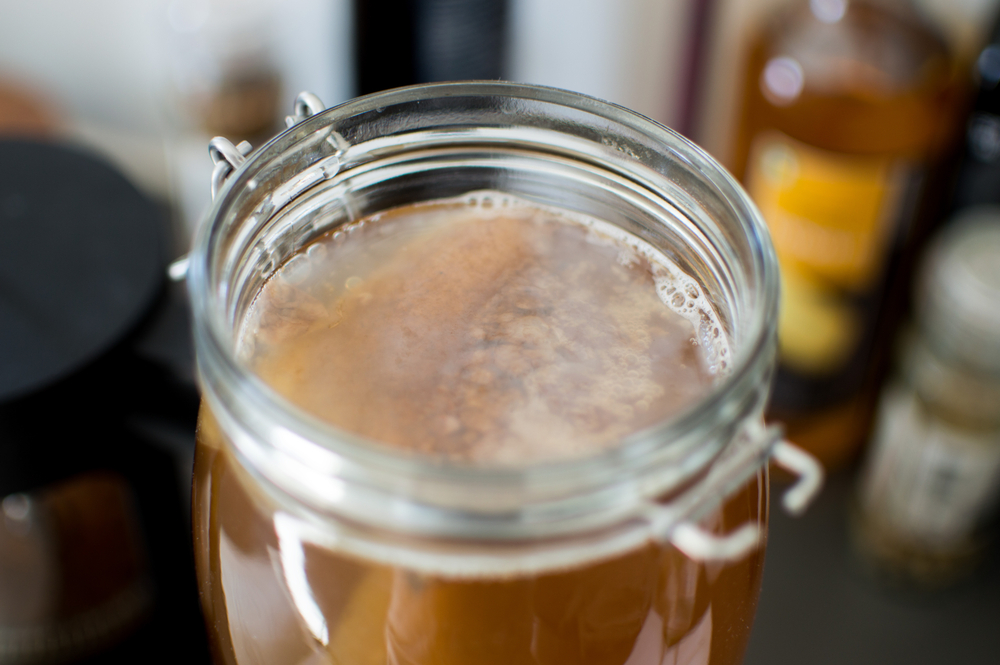Making your own kombucha is an easy way to access the health benefits of this fermented tea. As with all fermented foods, making your own kombucha also carries risks. Properly brewed homemade kombucha is safe, full of vitamins and antioxidants, and delicious.
Table of Contents
What Are the Benefits of Homemade Kombucha?
Homemade kombucha contains healthy enzymes, antioxidants, good bacteria, and probiotics. Homemade kombucha also helps:
- Strengthen your immune system. Healthy bacteria in kombucha help strengthen your body’s functions.
- Improve gut health. Kombucha is teeming with microorganisms that help restore your natural gut microbiome. Kombucha’s probiotics can help improve digestion.
- Promote healthy skin. The antioxidants protect against cell damage.
- Protect against heart disease. Kombucha helps increase your metabolism so you can burn more fat, reducing your cholesterol and helping you lose weight.
Aside from the health benefits, homemade kombucha:
- Is less expensive than store-bought. Most store-bought kombucha is over $3 per 16 oz bottle. Homemade kombucha costs a fraction of that.
- Is easy to brew. Tending to your kombucha takes just a few minutes each day.
- Offers creativity and self-satisfaction. Experiment with flavors and let your creative juices flow. Make each batch your own by adding the precise ingredients you prefer.
Is Homemade Kombucha Safe for Kids?
If homemade kombucha is brewed correctly, it should be safe for kids and adults*. It has a small amount of alcohol, typically around 0.5% per bottle, and unpasteurized ingredients. It’s always best to exercise caution when serving kombucha to kids.
The fermentation time determines the exact alcoholic content. The longer it ferments, the higher in alcohol. It’s difficult to tell the exact alcoholic content of homebrewed kombucha since it is not monitored like commercial kombucha.
One way to ensure the alcoholic content isn’t too high is to refrigerate your brew after it finishes the second ferment. If you store finished kombucha at room temperature, it continues to ferment the sugars into alcohol.

*Homemade kombucha is raw and unpasteurized. It contains bacteria and yeast that may be unsafe for pregnant or breastfeeding women. Individuals with compromised immune systems should also exercise caution when drinking kombucha.
Ask your doctor if you have any questions about drinking kombucha.
How Do You Know If Your Homemade Kombucha Is Safe?
Homemade kombucha doesn’t always look the same. Some SCOBYs float while others sink. Sometimes yeast and tiny pieces of SCOBYs form on the bottom of your brew or float in the tea. The more you homebrew, the more familiar you’ll be with how kombucha should look and smell.
Here are three changes you should notice while brewing homemade kombucha:
- Kombucha should lighten in color as it ferments. Kombucha starts dark brown in color. While it ferments, the yeast consumes the sugars and tea. Your finished kombucha should be lighter in color.
- Finished kombucha smells like vinegar. When you start the fermentation process, your kombucha smells like sweet tea. After about seven days, you should notice the smell change.
- You’ll notice a pellicle, or baby SCOBY, forming on the top of your brew. Don’t confuse this with mold! A pellicle is a thin membrane that naturally results from the fermentation process. It is translucent or white and usually forms across the top of your brewing jar.
If you prefer science over visual and olfactory cues, you can also test the pH of your kombucha. Ideally, homemade kombucha should have a pH of between 2.5 and 3.5.
Check your kombucha tea to ensure it is within the target range, but don’t use the results as the only factor to determine if it’s safe to drink. pH should only be used as one factor, along with smell and color tests.

4 Signs Your Homebrewed Kombucha is Not Safe to Drink
If you notice any of these signs, your homebrewed kombucha is unsafe to drink. Throw out your entire batch of kombucha, including your kombucha SCOBY, and sanitize your brewing equipment.
- Mold. Kombucha mold looks like mold on other food. It is usually fuzzy and forms in circles at the top of your brewing jar. Kombucha mold can be white, green, blue, black, or brown. If you see any signs of mold in your homebrew, it’s not safe.
- Your fermented tea still tastes like sweet tea. After seven days, your kombucha tea should taste less sweet and smell like vinegar. If it still tastes sweet, it is not fermenting correctly.
- Your kombucha tastes and smells extremely vinegary. Your homemade kombucha should smell and taste slightly vinegary but still be pleasant to drink. If you can’t tolerate the taste, your kombucha may be too acidic and could be harmful.
- Your kombucha is completely flat. Kombucha gains most of its carbonation after the second fermentation. After the first fermentation, however, it should be a bit fizzy. If it’s not, it may not be fermenting correctly.
What Happens if You Drink Bad Homemade Kombucha?
Many brewers have had success with making kombucha. However, kombucha is a fermented food at risk for contamination with bad bacteria or spoilage.
If you drink bad homemade kombucha, you may experience these side effects:
- Allergic Reactions
- Headache
- Infection
- Nausea
- Stomach Upset
- Vomiting
If you experience any of these symptoms after consuming kombucha, contact a medical professional.
4 Tips for Safely Brewing Kombucha at Home
Many people safely brew kombucha at home. If you’re interested in brewing kombucha, make sure you:
- Ferment at the correct temperature. Temps below 65 °F or above 90 °F may yield unsafe kombucha tea.
- Follow a tested kombucha recipe. Kombucha needs the correct ratio of tea to sugar to ferment safely.
- Get your SCOBY from a reputable source. You can find SCOBYs online or get one from a friend who is homebrewing successfully.
- Use glass containers and stainless steel equipment. It’s easy to sanitize glass and stainless steel to ensure it’s bacteria-free. Cover your fermenting tea with breathable cloth, such as cheesecloth or a coffee filter, and secure it with a rubber band. Kombucha needs good airflow during the first fermentation.
- Never ferment in ceramic pots. Acids in your kombucha will leech the ceramic glaze into your brew, potentially leading to lead poisoning. Transfer your finished kombucha into sterile glass jars for the second fermentation.
When in doubt, throw it out! If you see signs or smells you don’t think are right, it’s better to lose the batch and start over than risk your health.

